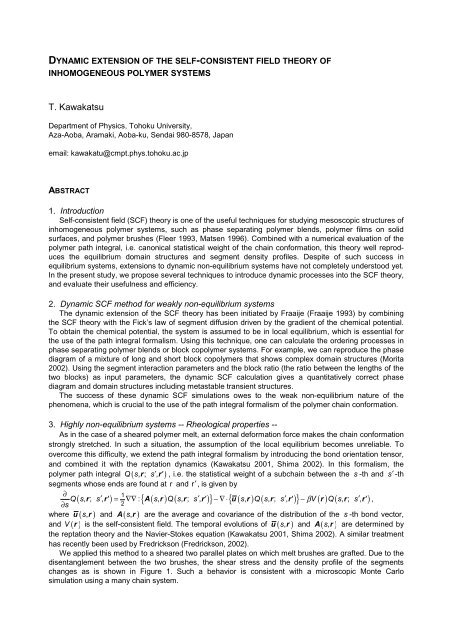Collapse of polymer brushes grafted onto planar ... - Wageningen UR
Collapse of polymer brushes grafted onto planar ... - Wageningen UR
Collapse of polymer brushes grafted onto planar ... - Wageningen UR
You also want an ePaper? Increase the reach of your titles
YUMPU automatically turns print PDFs into web optimized ePapers that Google loves.
DYNAMIC EXTENSION OF THE SELF-CONSISTENT FIELD THEORY OF<br />
INHOMOGENEOUS POLYMER SYSTEMS<br />
T. Kawakatsu<br />
Department <strong>of</strong> Physics, Tohoku University,<br />
Aza-Aoba, Aramaki, Aoba-ku, Sendai 980-8578, Japan<br />
email: kawakatu@cmpt.phys.tohoku.ac.jp<br />
ABSTRACT<br />
1. Introduction<br />
Self-consistent field (SCF) theory is one <strong>of</strong> the useful techniques for studying mesoscopic structures <strong>of</strong><br />
inhomogeneous <strong>polymer</strong> systems, such as phase separating <strong>polymer</strong> blends, <strong>polymer</strong> films on solid<br />
surfaces, and <strong>polymer</strong> <strong>brushes</strong> (Fleer 1993, Matsen 1996). Combined with a numerical evaluation <strong>of</strong> the<br />
<strong>polymer</strong> path integral, i.e. canonical statistical weight <strong>of</strong> the chain conformation, this theory well reproduces<br />
the equilibrium domain structures and segment density pr<strong>of</strong>iles. Despite <strong>of</strong> such success in<br />
equilibrium systems, extensions to dynamic non-equilibrium systems have not completely understood yet.<br />
In the present study, we propose several techniques to introduce dynamic processes into the SCF theory,<br />
and evaluate their usefulness and efficiency.<br />
2. Dynamic SCF method for weakly non-equilibrium systems<br />
The dynamic extension <strong>of</strong> the SCF theory has been initiated by Fraaije (Fraaije 1993) by combining<br />
the SCF theory with the Fick’s law <strong>of</strong> segment diffusion driven by the gradient <strong>of</strong> the chemical potential.<br />
To obtain the chemical potential, the system is assumed to be in local equilibrium, which is essential for<br />
the use <strong>of</strong> the path integral formalism. Using this technique, one can calculate the ordering processes in<br />
phase separating <strong>polymer</strong> blends or block co<strong>polymer</strong> systems. For example, we can reproduce the phase<br />
diagram <strong>of</strong> a mixture <strong>of</strong> long and short block co<strong>polymer</strong>s that shows complex domain structures (Morita<br />
2002). Using the segment interaction parameters and the block ratio (the ratio between the lengths <strong>of</strong> the<br />
two blocks) as input parameters, the dynamic SCF calculation gives a quantitatively correct phase<br />
diagram and domain structures including metastable transient structures.<br />
The success <strong>of</strong> these dynamic SCF simulations owes to the weak non-equilibrium nature <strong>of</strong> the<br />
phenomena, which is crucial to the use <strong>of</strong> the path integral formalism <strong>of</strong> the <strong>polymer</strong> chain conformation.<br />
3. Highly non-equilibrium systems -- Rheological properties --<br />
As in the case <strong>of</strong> a sheared <strong>polymer</strong> melt, an external deformation force makes the chain conformation<br />
strongly stretched. In such a situation, the assumption <strong>of</strong> the local equilibrium becomes unreliable. To<br />
overcome this difficulty, we extend the path integral formalism by introducing the bond orientation tensor,<br />
and combined it with the reptation dynamics (Kawakatsu 2001, Shima 2002). In this formalism, the<br />
<strong>polymer</strong> path integral Q ( s, r; s′ , r ' ) , i.e. the statistical weight <strong>of</strong> a subchain between the s -th and s′ -th<br />
segments whose ends are found at r and r ′ , is given by<br />
∂<br />
1<br />
Q( s, r; s′ , r') = ∇∇: { A( s, r) Q( s, r; s′ , r') } −∇⋅{ u( s, r) Q( s, r; s′ , r') } −βV(<br />
r) Q( s, r; s′ , r ')<br />
,<br />
∂s<br />
2<br />
where u( s,<br />
r ) and A( s,<br />
r ) are the average and covariance <strong>of</strong> the distribution <strong>of</strong> the s -th bond vector,<br />
and V ( r ) is the self-consistent field. The temporal evolutions <strong>of</strong> u( s,<br />
r ) and A( s,<br />
r ) are determined by<br />
the reptation theory and the Navier-Stokes equation (Kawakatsu 2001, Shima 2002). A similar treatment<br />
has recently been used by Fredrickson (Fredrickson, 2002).<br />
We applied this method to a sheared two parallel plates on which melt <strong>brushes</strong> are <strong>grafted</strong>. Due to the<br />
disentanglement between the two <strong>brushes</strong>, the shear stress and the density pr<strong>of</strong>ile <strong>of</strong> the segments<br />
changes as is shown in Figure 1. Such a behavior is consistent with a microscopic Monte Carlo<br />
simulation using a many chain system.

















